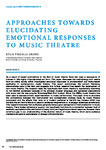APPROACHES TOWARDS ELUCIDATING EMOTIONAL RESPONSES TO MUSIC THEATRE
| dc.contributor.author | Green, Ryan | |
| dc.date.accessioned | 2022-02-11T18:03:32Z | |
| dc.date.available | 2022-02-11T18:03:32Z | |
| dc.date.issued | 2022-02 | |
| dc.identifier.uri | http://hdl.handle.net/10026.1/18757 | |
| dc.description.abstract |
<jats:p>As a result of recent publications in the field of music theatre there has been a resurgence of interest in this highly misunderstood art form. This paper discusses the methodology and results from an online survey which investigated emotional responses to orchestration1 and instrumental aesthetics in contemporary music theatre. This report summarises the current literature, demonstrates gaps in the field, and suggests how further research may benefit the development of new music theatre. The research tests the hypothesis that music theatre is accidentally alienating to non-familiar audiences because of its complex musical language and perceived associations with opera and the ever-popular Broadway/West End musical. Since the 1960s, music theatre has been used to express artistic experimentalism in music performance. This paper aims to elucidate the connections between the instrumental and orchestration choices made by music theatre composers and the effects they have on a modern audience to identify key indexes which may indicate the art form’s failure to capture audience imaginations or to engage audiences emotionally. This research indicates that audiences generally have a good perception of instrumentation in music theatre. There is also evidence to support the hypothesis that there is a connection between lack of aesthetic appreciation (the admiration of beauty in art) and negative emotional response. However there remains a gap in our understanding of the abstract nature of music theatre, which some audience members struggle to comprehend or engage with emotionally.</jats:p> | |
| dc.format.extent | 81-88 | |
| dc.language | en | |
| dc.language.iso | en | |
| dc.publisher | South West Doctoral Training Partnership | |
| dc.title | APPROACHES TOWARDS ELUCIDATING EMOTIONAL RESPONSES TO MUSIC THEATRE | |
| dc.type | journal-article | |
| plymouth.issue | 1 | |
| plymouth.volume | 7 | |
| plymouth.publication-status | Published | |
| plymouth.journal | TRANSFORMATION | |
| dc.identifier.doi | 10.47967/TOR2022TRANS.VOL7.12 | |
| plymouth.organisational-group | /Plymouth | |
| plymouth.organisational-group | /Plymouth/Faculty of Arts, Humanities and Business | |
| plymouth.organisational-group | /Plymouth/Users by role | |
| plymouth.organisational-group | /Plymouth/Users by role/Academics | |
| dcterms.dateAccepted | 2022-01-14 | |
| dc.rights.embargodate | 2022-2-25 | |
| dc.rights.embargoperiod | Not known | |
| rioxxterms.versionofrecord | 10.47967/TOR2022TRANS.VOL7.12 | |
| rioxxterms.licenseref.uri | http://www.rioxx.net/licenses/all-rights-reserved | |
| rioxxterms.licenseref.startdate | 2022-02 | |
| rioxxterms.type | Journal Article/Review |


